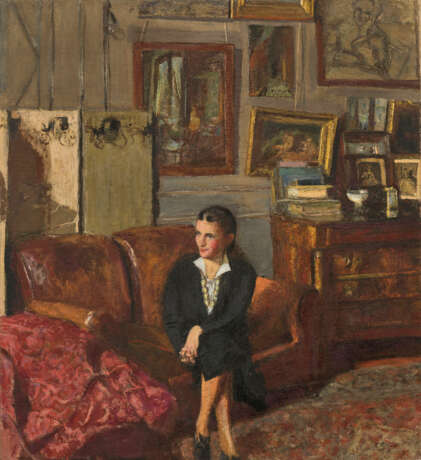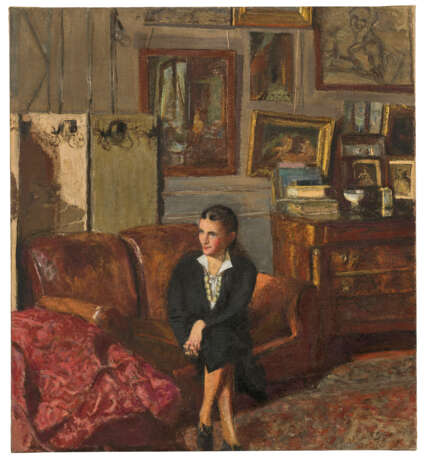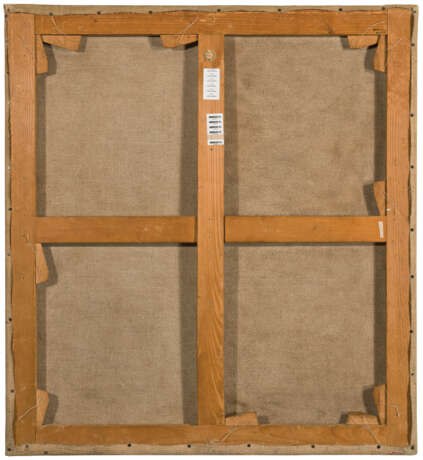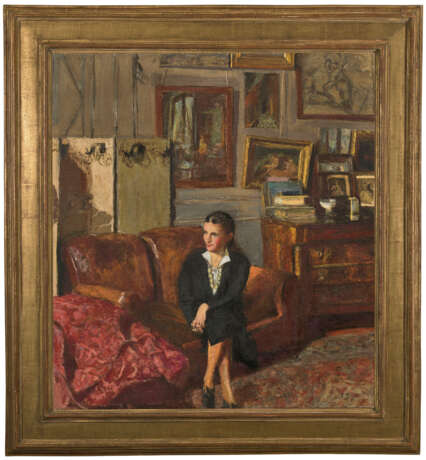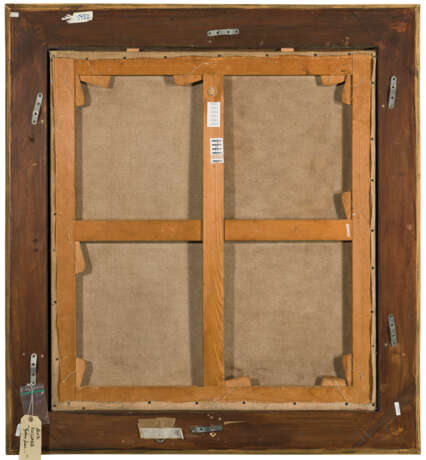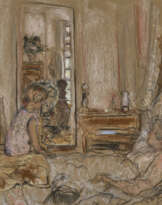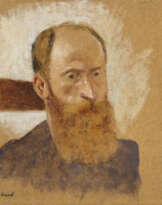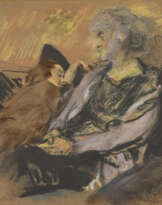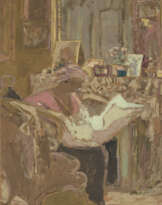ID 832351
Lot 158 | Édouard Vuillard (1868-1940)
Estimate value
€ 80 000 – 120 000
Portrait de Madame Jean-Henri Adam
signé 'E. Vuillard' (en bas à droite)
peinture à la colle sur toile
89.2 x 81.1 cm.
Peint en 1936-37
signed 'E. Vuillard' (lower right)
peinture à la colle on canvas
35 1/8 x 31 7/8 in.
Painted in 1936-37
Provenance
Jean-Henri Adam, Paris (commandé auprès de l'artiste le 9 octobre 1936).
Collection particulière, Paris.
Vente, Me Boisgirard, Paris, 26 juin 2002, lot 54.
Acquis au cours de cette vente par la famille du propriétaire actuel.
Literature
W. George, 'Vuillard et l'âge heureux' in L'Art vivant, No. 221, mai 1938, p. 34 (illustré).
C. Roger-Marx, Vuillard et son temps, Paris, 1945, p. 94.
A. Salomon et G. Cogeval, Vuillard, Le Regard innombrable, Catalogue critique des peintures et pastels, Paris, 2003, vol. III, p. 1528, no. XII-139 (illustré).
Exhibited
Paris, Musée des Arts Décoratifs, Exposition E. Vuillard, mai-juillet 1938, p. 38, no. 214.
Post Lot Text
Peint en 1936-37, le Portrait de Madame Jean-Henri Adam est représentatif des thèmes de prédilection de Vuillard : l’intérieur domestique et le portrait, deux catégories stylistiques qui définissent la dernière période de sa carrière.
« Je ne fais pas de portraits, je peins les gens chez eux » disait l’artiste (Vuillard, cité dans G. Cogeval, Édouard Vuillard, cat. exp., Washington, D.C., 2003, p. 356). Si le Portrait de Madame Jean-Henri Adam montre son sujet dans l’appartement parisien de Vuillard, l’atmosphère est la même : elle semble faire partie de son environnement, peut-être même définie par lui. Dans ce tableau, Madame Jean-Henri Adam est représentée assise, à l’avant de la composition ; les murs, remplis de tableaux, constituent une mosaïque vibrante, chaque rectangle ajoutant davantage à la composition. L’accent est ainsi mis sur la surface picturale et la structure décorative du tableau, caractéristiques picturales que Vuillard développa au contact des Nabis. On retrouve également un intimisme absorbant, caractéristique des intérieurs de Vuillard tout au long de sa vie.
Dans le Portrait de Madame Jean-Henri Adam, le modèle pose dans un tailleur noir sobre et élégant relevé d’un collier d’ivoire, assise sur un canapé en cuir brun dans la chambre de l’appartement de l’artiste à Paris, place Vintimille. Dans cette œuvre, le sentiment d’intimité, et même d’autobiographie, est accentué par la présence des propres toiles de Vuillard sur les murs. Au milieu, accroché au-dessus de Madame Adam, se trouve Madame Vuillard cousant à la fenêtre, œuvre de 1916-17 (S et C X-160) ; à sa gauche, on aperçoit Le Palier rue de Miromesnil (S et C II-99), un tableau nabi datant de 1891 et Madame Vuillard à table à la Closerie des Genêts (un grand fusain sur papier qui figurera dans le supplément au catalogue raisonné de l’artiste). La composition comprend également un paysage de Corot et un portrait de Constantin Guys. Enfin, à gauche de la composition, se trouve le paravent de Bonnard Promenade des nourrices, frise des fiacres, réalisé en 1897.
Comme en témoigne la présente œuvre, Édouard Vuillard est connu pour sa capacité à dépeindre l’intimité de la vie quotidienne. Si le sujet reste une constante dans l’œuvre de l’artiste, son style se modifie au tournant du siècle. C’est à cette époque que naît le mouvement avant-gardiste nabi, dont il est l’un des principaux participants. Le changement stylistique de Vuillard peut être attribué en grande partie à ses nouvelles fréquentations. Sa vie quotidienne passe des cercles théâtraux et littéraires des années 1890 au milieu mondain de la haute société, dans lequel il est introduit par ses marchands, les frères Bernheim. Ils encouragent Vuillard à adapter son style intime à une forme plus formelle de portrait, en montrant ces nouvelles connaissances dans l’intimité de leurs maisons élégantes et richement meublées.
Portrait de Madame Jean-Henri Adam, painted in 1936-37 is representative of the artist’s favourite themes: the domestic interior and portraiture, two stylistic categories which defined the artist’s later career. ‘I don’t paint portraits, I paint people in their homes’ the artist one said (Vuillard, quoted in G. Cogeval, Édouard Vuillard, exh. cat., Washington, D.C., 2003, p. 356). While Portrait de Madame Jean-Henri Adam shows his subject within Vuillard’s flat in Paris, the atmosphere is the same: she appears to be a part of her surroundings, perhaps even defined by them. In this picture, Madame Jean-Henri Adam is shown seated, at the front of the composition, the walls, filled with pictures, resulting in an vibrant loose mosaic, each rectangle adding more to the composition. In this way, the focus on the painterly surface and decorative structure of the picture that had developed during Vuillard’s involvement with the Nabis is clear. Likewise, there is an absorbing intimisme, a characteristic that remained in Vuillard’s interiors throughout his life. In Portrait de Madame Jean-Henri Adam, the sitter, is posing in a sober, elegant black tailleur, with an ivory necklace, seated on a brown leather couch in the bedroom of the artist’s flat in Paris, Place Vintimille. The sense of privacy, and even of autobiography, in Portrait de Madame Jean-Henri Adam is accentuated by the presence of Vuillard’s own works on the walls. In the middle, visible hanging above Madame Adam, is Madame Vuillard cousant a la fenêtre of 1916-17 (S & C X-160); on its left, there is Le Palier rue de Miromesnil (S & C II-99) a Nabi painting, dated 1891 and Madame Vuillard à table à la Closerie des Genêts (a large charcoal on paper which will be included in the supplement to the catalogue raisonné of the artist). Also visible in the composition is a Corot landscape and a portrait by Constantin Guys. Finally, on the left of the composition, Bonnard’s decorative screen, Promenade des nourrices, frise des fiacres, executed in 1897.
Édouard Vuillard is known for his talent for portraying the intimacy of daily life. While his subject matter remained a constant in the artist’s work, his style altered at the turn of the century. It was at that time that the avant-garde Nabi group, in which he was a primary participant. Vuillard’s stylistic change can be attributed in large part to new social connections. His daily life shifted from the theatre and literary circles of the 1890s to the fashionable upper class milieu to which he was introduced by his dealers, the Bernheim brothers. They encouraged Vuillard to adapt his intimate style to a more formal brand of portraiture, showing these new acquaintances in the intimacy of their elegant and elaborately-furnished homes.
| Artist: | Édouard Vuillard (1868 - 1940) |
|---|---|
| Applied technique: | Oil on canvas |
| Auction house category: | Paintings |
| Artist: | Édouard Vuillard (1868 - 1940) |
|---|---|
| Applied technique: | Oil on canvas |
| Auction house category: | Paintings |
| Address of auction |
CHRISTIE'S 9 Avenue Matignon 75008 Paris France | ||||||||||||||
|---|---|---|---|---|---|---|---|---|---|---|---|---|---|---|---|
| Preview |
| ||||||||||||||
| Phone | +33 (0)1 40 76 85 85 | ||||||||||||||
| Fax | +33 (0)1 40 76 85 86 | ||||||||||||||
| Conditions of purchase | Conditions of purchase | ||||||||||||||
| Shipping |
Postal service Courier service pickup by yourself | ||||||||||||||
| Payment methods |
Wire Transfer | ||||||||||||||
| Business hours | Business hours
|
